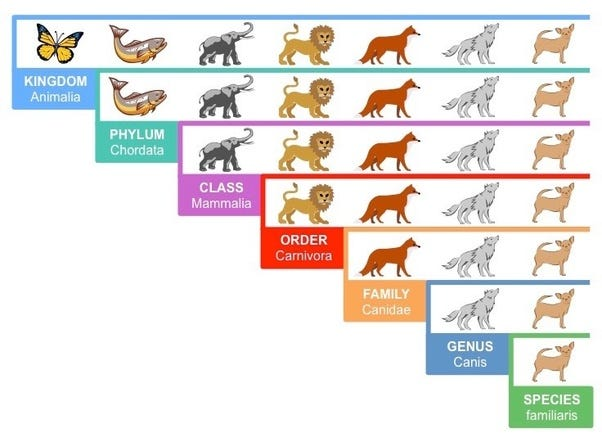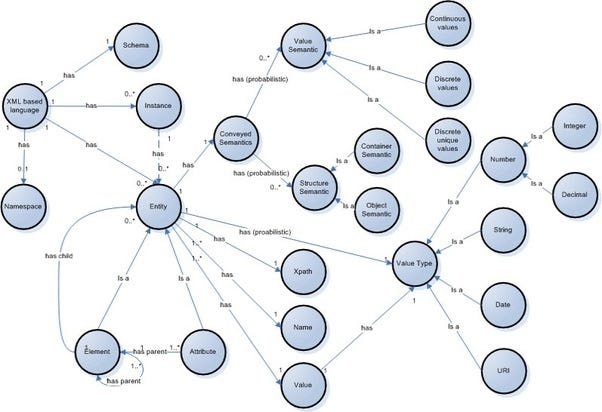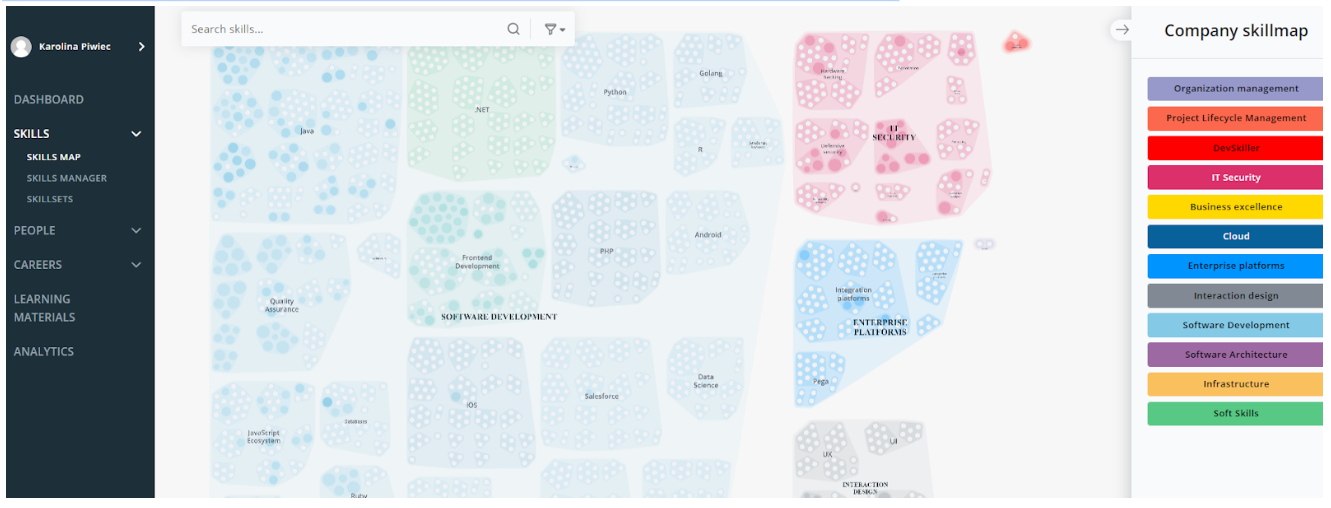
Maximizar o talento: como uma estrutura de ontologia de competências pode beneficiar a sua organização

As workplaces become more skills-focused, in order to plug knowledge and skill gaps within, businesses are turning to skills-based working models. With that, comes the need for a skills ontology framework. This article will discuss what a skills ontology is, and using, the example of DevSkiller TalentBoost, why such a tool can be crucial to organizing the future of your enterprise.
What is a skills ontology?
The term ‘ontology infer skills’ may sound complex, and, particularly in its original metaphysical sense, it is a little. In relation to business management, a skills ontology refers to sets of skills and the relationship between those skills. In relation to business management, it is a way to easily define the various skills that make up a specific job, rather than relying on traditional job descriptions.
A skills ontology provides a complete picture of an organization’s workforce skills and their interconnections, enabling more strategic talent management decisions. It facilitates internal mobility, upskilling, and reskilling, positively impacting retention rates.
Skills gaps exist because technological advancements outpace the rate at which employees can learn the new skills required. So, companies adopt a skills-based workplace modelto organize the learning and development of employees, and skills ontologies allow those companies to easily identify and close skills gaps as they arise. A skills ontology allows enterprises to identify the skills that make up any role and to organize these skills insights into a skills map or skills cloud.
By analyzing skills data through ontologies, organizations can anticipate future skill requirements and make well-informed talent decisions.
By arranging skills and knowledge development into a structured form, skills ontologies allow for cohesion and relationships between skills and departments, and for learning to become a standardized, everyday practice within the workplace. Thus, creating a process of constantly ongoing professional development.
Tools like DevSkiller TalentBoost take the complex job of organizing the critical skills of an entire organization and structure them into simple skills maps that can be utilized for the ongoing skills development of the whole company. Therefore closing any future workforce skills gap that may appear.
Key benefits of a skills ontology framework
A skills ontology provides many benefits to simplify the workforce management of leading companies:
- Create a common language by which to discuss skills development
- Allows employers to easily update roles with new skills
- Allows employees to take an interest in their own skills development
- Future job announcements can be easily tailored to include new skills
- Assessing employee skills becomes as simple as any other everyday task
- Performance reviews can be approached methodically, with precise performance evaluations—with promotions being based on the achievement of solid learning goals
- Create clear development goals
The 10 benefits of introducing a skills management platform at your organization
Create a common language by which to discuss skills development
A skills ontology creates a common language by which to categorize skills and talk about skills development. Employees can be easily arranged into teams or tribes for given projects. Work is no longer based solely on traditional job descriptions, making for a flexible, more agile workforce.
Allows employers to easily update roles with new skills
The truth is, modern tech roles advance so quickly that it is no good simply hiring someone for a role anymore. That role will have changed before their employment contract is signed. Skills ontologies allow companies to constantly update the skills of any position, allowing employees to keep on developing skills as they arise or for employers to update the skills required for a role continuously.
Allows employees to take an interest in their own skills development
Employees can also take an interest in their personal skills development. They can look at their skill data and personal skills cloud and, along with their employer, they can identify and target specific areas of improvement. Access to simple skills data can give workers a new lease of life in their role, and a chance to improve.
Future job announcements can be easily tailored to include new skills
When it comes to hiring, HR leaders can easily identify and adapt what is required to be able to perform the job responsibilities of a specific role well. Advertised jobs can be updated with the latest skills required.
The creation of a skills map, allows companies to easily identify what is needed from a new hire, to understand skills, and to have the confidence to know what to look for from the shortlisted job candidates.
A skills ontology creates clear development goals
Skills and skill ontologies allow for roles to change and job descriptions to be constantly evolving. For instance, if a new programming language emerges, a basic understanding of that language may need to be factored into the role of front-end developer, for example. A practical environment of learning and development can be created meaning employees target the right skills to work on, to be able to improve their chances of progressing to become a team leader or manager.
How to build a skills ontology framework
Define the scope and purpose
Before diving into building a skills ontology framework, it’s crucial to clearly define its scope and purpose. Determine what specific areas of your organization the ontology will cover and what objectives it aims to achieve. This could range from improving talent acquisition to enhancing employee development programs.
Choose the right skills ontology technology
Selecting the appropriate technology is vital for creating an effective skills ontology. Consider platforms that offer AI-powered tools to automate the process of identifying and defining skills, and can update the ontology in real-time. This ensures your framework remains current and adaptable to changing business needs.
Gather input from stakeholders
Involve key stakeholders from various departments to ensure the ontology accurately reflects the skills needed across the organization. This collaborative approach helps in creating a comprehensive and relevant framework that aligns with both current and future business requirements.
Conceptualize the structure
Design a structure that allows for easy navigation and understanding of skills relationships. This might involve creating hierarchies, categories, or clusters of related skills. The structure should be flexible enough to accommodate new skills and evolving job roles.
Identify skill relationships
Map out how different skills relate to each other, to job roles, and to departments. This interconnected approach allows for a more nuanced understanding of skill sets and their applications across the organization.
Integrate with existing systems
Ensure that your skills ontology framework can integrate seamlessly with existing HR and talent management systems. This integration is crucial for leveraging the ontology effectively across various HR processes, from recruitment to performance management.
Skills ontology vs taxonomy
The terms skills ontology works in taxonomy and skills ontology are often used interchangeably. This is because, to some extent, there is considerable overlap. However, there are subtle but important differences.
What is a skills taxonomy?
A skill taxonomy, is a hierarchical structure of broad and more specific categories. Therefore, a skills taxonomy is used to organize categories of skills, relevant to their position within skill sets.

Fonte: Medium.com
“A skills taxonomy is a structured list of skills defined at the organization level that identifies the capabilities of a business in a quantifiable way. Essentially, it is a system that classifies skills within an organization into groups and clusters other skills.”—AIHR
A skills ontology is a less rigid approach to organizing how different skills are within a given category. A skills ontology allows employees to be able to map the connections between different skills in a more detailed way.
“Taxonomies can retrieve a spreadsheet file, whereas ontologies can retrieve data from individual cells in the spreadsheet. Ontologies can traverse data in a database.“— The Accidental Taxonomist
This example shows an ontology framework. Notice how there is no hierarchical structure, allowing for a much more fluid outcome.

Fonte: Medium.com
The example below shows the DevSkiller TalentBoost skills ontology framework. Within the skills map (software development) there are skill sets (Java, .Net, Python) and within each skill set, are individual skills. By arranging skills in this way (and not in a taxonomical format), TalentBoost skill ontology, is able to show the direct relationship between skills in the ‘.Net’ or ‘Java’ skill sets, but also show how those skill sets are connected under the wider umbrella of ‘software development’.

Source: DevSkiller
Challenges in implementing skills ontologies
While skills ontologies offer numerous benefits, organizations may face challenges during implementation:
- Complexity: Creating a comprehensive skills ontology can be complex, especially for large organizations with diverse skill sets.
- Maintenance: Keeping the ontology up-to-date requires ongoing effort as new skills emerge and existing ones evolve.
- Integration: Ensuring seamless integration with existing HR systems and processes can be technically challenging.
- Adoption: Encouraging widespread adoption and proper use of the ontology across the organization may require significant change management efforts.
- Data Quality: Maintaining accurate and consistent data within the ontology is crucial for its effectiveness.
Overcoming these challenges requires careful planning, robust technology solutions, and ongoing commitment from leadership and stakeholders.
How skills ontologies like DevSkiller TalentBoost impact hiring
Fonte: Youtube
With the use of artificial intelligence, talent management platforms like TalentBoost can have a profound impact on an organization.
Read: Consideration factors when choosing a Talent management solution
Accelerate employee development
Being able to provide employees with actionable feedback, allows for conversations about specific areas of development within the workforce. Meaning, that employees are given a tangible road to success. Not only linear success. An ontological framework allows companies to easily identify those employees with the most potential working in other teams or sectors. In a taxonomical working model, it is harder to identify potential outside your immediate scope of interest. As a result, internal mobility increases and it becomes easier to fill skills gaps by looking in-house.
Cut talent acquisition costs
Talent acquisition costs can be cut dramatically by employing a talent management tool like TalentBoost. Not only is it easier for HR leaders to define the exact skills needed for a role when making new hires; but it also becomes easier to upskill and reskill workers already with the organization. Hiring managers are able to clearly identify in which areas an employee can strengthen their skills, in order to be considered qualified for a different role.
Boost employee morale among the existing workforce
Talent management platforms boost employee morale in that current employees feel their talent development and needs are being considered and that they have a clear path of progression.
Fast-track talented employees
Talent management platforms allow organizations to fast-track those employees that demonstrate the most skills relate the most potential. Meaning the best employees are selected to progress quickly.
Core components of a skills ontology framework
Structuring of Skills
A well-designed skills ontology framework should have a clear structure that organizes skills into logical categories or clusters. This structure helps in easy navigation and understanding of the skills landscape within an organization.
Mapping skill relationships
One of the key strengths of a skills ontology is its ability to map out the relationships between individual skills, job roles, and departments. This interconnected view provides valuable insights into how skills relate to each other and to various aspects of the organization.
Skill levels and proficiencies
Incorporating skill levels or proficiency scales into the ontology allows for more nuanced understanding and assessment of employee capabilities. This can range from basic to expert levels, providing a clear pathway for skill development.
Compatibility with industry standards
Ensuring that the skills ontology aligns with industry standards and recognized skill frameworks enhances its credibility and usefulness, especially in sectors with established competency models.
The role of technology in creating skills ontologies
Technology plays a crucial role in developing and maintaining effective skills ontologies:
- AI and Machine Learning: These technologies can automate the process of identifying, defining, and updating skills in real-time, keeping the ontology current with evolving industry trends.
- Data Analytics: Advanced analytics tools can provide insights into skill gaps, predict future skill needs, and offer personalized development recommendations.
- Integration Capabilities: Modern skills ontology platforms can seamlessly integrate with existing HR systems, enhancing their utility across various HR processes.
- User-Friendly Interfaces: Intuitive interfaces make it easier for employees and managers to interact with the skills ontology, encouraging wider adoption and use.
Common mistakes organizations Make with skills ontologies
Dismissing them based on cost
Some organizations may overlook the long-term benefits of skills ontologies due to initial implementation costs. However, the return on investment in terms of improved talent management and workforce planning can be substantial.
Failing to update regularly
Skills ontologies need to be dynamic to remain relevant. Failing to update them regularly can lead to outdated skill sets that don’t reflect current industry needs or technological advancements.
Overlooking soft skills
While technical skills are often the focus, neglecting soft skills in the ontology can result in an incomplete picture of employee capabilities and potential.
Adding too much or too little detail
Striking the right balance in the level of detail is crucial. Too much granularity can make the ontology unwieldy, while too little detail may not provide sufficient insights for effective talent management.
Future trends and strategic value of skills ontology frameworks
Looking ahead, skills ontology frameworks are set to play an increasingly vital role in strategic workforce planning:
- Predictive analytics: Advanced ontologies will leverage AI to predict future skill needs, allowing organizations to proactively develop their workforce.
- Percursos de aprendizagem personalizados: By integrating with learning management systems, skills ontologies will enable highly personalized development plans for employees.
- Gig economy integration: As the gig economy grows, skills ontologies will help organizations better manage and utilize freelance and contract workers alongside their permanent workforce.
- Cross-industry skill mapping: Future ontologies may facilitate better understanding of how skills translate across different industries, enhancing workforce mobility.
Using skills ontologies to address the skills gap
Skills ontologies are becoming crucial tools in addressing the growing skills gap in various industries:
- Identifying current gaps: 47% of HR managers admitted they didn’t know what skills gaps existed in their current workforce, highlighting the need for skills ontologies.
- Quantifying impact: 34% of HR professionals believed their organization’s skills gap had a negative impact on efficiency, while 25% said it led to increased expenses and impeded business growth, innovation, and competitiveness.
- Strategic planning: By providing a clear view of the current skill landscape and future needs, skills ontologies enable organizations to strategically plan their hiring, training, and development initiatives.
- Targeted upskilling: With a comprehensive skills ontology, companies can create targeted upskilling programs to address specific gaps, ensuring more efficient use of training resources.
- Enhanced talent acquisition: Skills ontologies help in crafting more accurate job descriptions and identifying candidates with the right skill sets, improving the quality of hires.
Final thoughts
DevSkiller TalentBoost is a software de gestão de competências built to define, measure, and manage digital skills. It uses an advanced skills ontology framework, to identify the precise areas an organization’s employees can progress. This model is agile and adaptable in the sense that as new technologies arise and develop, which they do every day, the framework is able to adapt and keep up with the rapidly moving pace of modern business.
Find out more about DevSkiller TalentBoost




